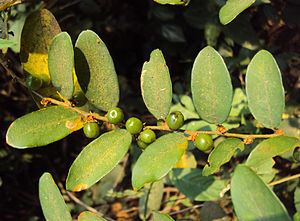Bridelia stipularis
Bridelia stipularis is a species of plant in the Phyllanthaceae family, which is native to various parts of Asia including India, Sri Lanka, Bangladesh, and the Andaman Islands. It is known for its medicinal properties and is used in traditional medicine systems in the regions where it is found.
Description[edit | edit source]
Bridelia stipularis is a small to medium-sized tree that can reach heights of up to 15 meters. The bark is grey and rough, with young branches being pubescent. The leaves of the plant are simple, alternate, and ovate or elliptic with a rounded base and acute tip. They are about 7-14 cm long and 3-6 cm wide, with a leathery texture and a green to dark green color. The stipules are distinctive, being long and slender.
The flowers of Bridelia stipularis are small, unisexual, and are found in axillary or terminal inflorescences. The male flowers are grouped in clusters, while the female flowers are usually solitary. The fruit is a small, spherical drupe, turning black when ripe.
Habitat and Distribution[edit | edit source]
Bridelia stipularis is found in a variety of forest habitats, from dry deciduous to moist deciduous forests, and also in secondary forests and forest edges. It prefers well-drained soils and is often found at low to medium elevations. Its distribution spans across South and Southeast Asia, indicating its adaptability to different tropical and subtropical climates.
Uses[edit | edit source]
In traditional medicine, various parts of Bridelia stipularis are used to treat a range of ailments. The bark is used for its astringent properties and to treat dysentery and diarrhea. The leaves and roots are used in the treatment of skin diseases and wounds, due to their purported antimicrobial and healing properties. Additionally, the plant is used in the treatment of respiratory conditions and fevers.
Conservation[edit | edit source]
While Bridelia stipularis is not currently listed as endangered, its habitat is under threat from deforestation and habitat degradation. Conservation efforts are necessary to ensure the survival of this species and the biodiversity of the ecosystems in which it is found.
Cultural Significance[edit | edit source]
In some cultures, Bridelia stipularis is also used in religious and cultural ceremonies. The tree is considered sacred in certain communities and is often planted around temples and in home gardens for its aesthetic value and shade.
Search WikiMD
Ad.Tired of being Overweight? Try W8MD's physician weight loss program.
Semaglutide (Ozempic / Wegovy and Tirzepatide (Mounjaro / Zepbound) available.
Advertise on WikiMD
|
WikiMD's Wellness Encyclopedia |
| Let Food Be Thy Medicine Medicine Thy Food - Hippocrates |
Translate this page: - East Asian
中文,
日本,
한국어,
South Asian
हिन्दी,
தமிழ்,
తెలుగు,
Urdu,
ಕನ್ನಡ,
Southeast Asian
Indonesian,
Vietnamese,
Thai,
မြန်မာဘာသာ,
বাংলা
European
español,
Deutsch,
français,
Greek,
português do Brasil,
polski,
română,
русский,
Nederlands,
norsk,
svenska,
suomi,
Italian
Middle Eastern & African
عربى,
Turkish,
Persian,
Hebrew,
Afrikaans,
isiZulu,
Kiswahili,
Other
Bulgarian,
Hungarian,
Czech,
Swedish,
മലയാളം,
मराठी,
ਪੰਜਾਬੀ,
ગુજરાતી,
Portuguese,
Ukrainian
Medical Disclaimer: WikiMD is not a substitute for professional medical advice. The information on WikiMD is provided as an information resource only, may be incorrect, outdated or misleading, and is not to be used or relied on for any diagnostic or treatment purposes. Please consult your health care provider before making any healthcare decisions or for guidance about a specific medical condition. WikiMD expressly disclaims responsibility, and shall have no liability, for any damages, loss, injury, or liability whatsoever suffered as a result of your reliance on the information contained in this site. By visiting this site you agree to the foregoing terms and conditions, which may from time to time be changed or supplemented by WikiMD. If you do not agree to the foregoing terms and conditions, you should not enter or use this site. See full disclaimer.
Credits:Most images are courtesy of Wikimedia commons, and templates Wikipedia, licensed under CC BY SA or similar.
Contributors: Prab R. Tumpati, MD

